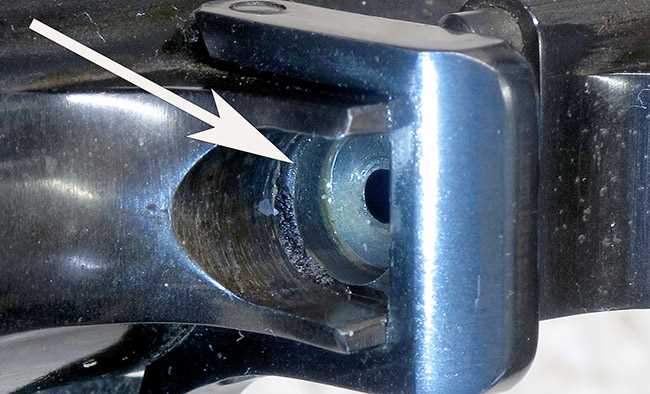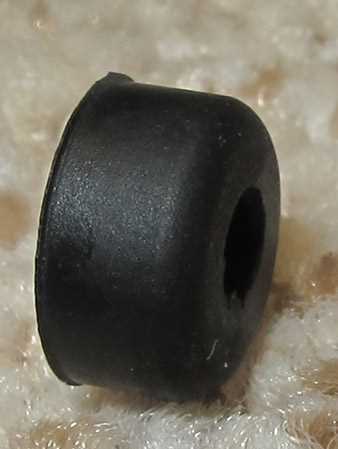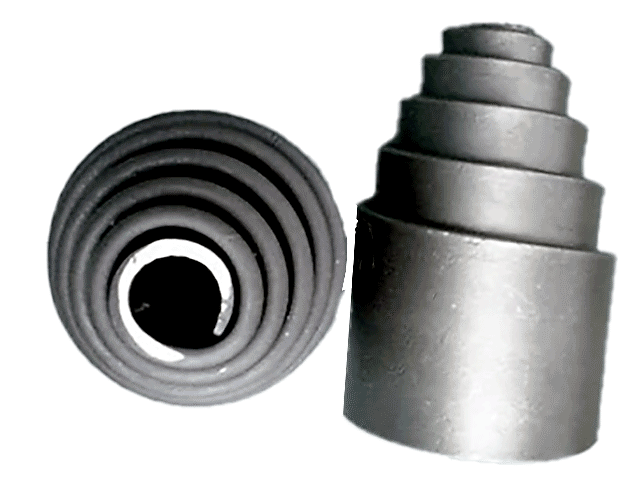What about Springers?
This report covers:
- What is a springer?
- The importance of seals
- Seal materials
- Types of springs
- Shooting springers
- Scoping a springer
- Scope height
- Scope length
- Summary
You guys may wonder where I get my ideas for this blog. Well, I have a Helper. Some mornings I wake up with a particular blog in mind and He tells me to think about it. I do and, glory be, a different but still great blog pops into my head.
This morning I was all set to write a report on the FWB 124 that I’m overhauling. I completed the lubrication and assembly yesterday afternoon, just so I could show it to you today. Then I realized that I had last reported on it just three days ago. That’s too soon for another report. Whatever shall I do?
You may remember that I am learning to play the ukulele. I often go online and watch various teachers explain how to do things that I can’t do yet — and there are a lot of them! Well, I was watching this one woman play a baritone ukulele when it dawned on me that she was the teacher I had followed for several weeks. You see, a baritone uke is set up with strings tuned to different notes than the more common sized ukes that I play, so she has to know where all those notes and cords are that are different than the notes and cords on the ukulele I was learning from her.
On top of that she also teaches guitar, which also has strings and is completely different than a ukulele. A uke usually has 4 strings while a guitar usually has six. A guitar is different enough that I figured someone could learn one without confusing it with the other. I play a tenor slide trombone and trap drums and don’t get confused between the two. But please don’t ask me to play a valve trombone or a kettle drum!
But this lady was doing the equivalent of that with two different ukuleles! How does she do that?
And then, as I was assembling the FWB 124 yesterday, it dawned on me that I was doing the same thing with airguns. From day to day I hop from a spring gun to a pre-charged pneumatic (PCP) to a multi-pump to a CO2 gun. I think nothing of it, but the technology has got to befuddle many who are new to airguns.
So this morning I thought I would address those things you have to keep in mind to succeed with each type of powerplant. And then the whole thing expanded in my mind. There aren’t just a few things; there are many — for each airgun powerplant!
So today I will start a SERIES on the things you need to know about airguns. I will start with spring guns. Hopefully I will get everything or almost everything into this one report. Let’s get started.
What is a springer?
Springer is the slang term for a spring-piston airgun. Forget gas rams, gas struts and gas pistons. If some kind of force thrusts a piston forward to rapidly compress a small amount of air, it’s a springer.
Sometimes there is a false piston that goes in the opposite direction from the real piston. It does that to counter the recoil or movement of the actual piston, and that makes that airgun recoilless. Then there is the powerplant with two pistons that come together like the clapping of hands. These are also recoilless and are also more powerful by design.
The importance of seals
The report on the FWB 124 has highlighted the importance of a piston seal, I hope. When the seal gets bad through damage or dry-rot the airgun stops working. We all know that PCPs and CO2 guns need good seals, but seals are just as important to spring guns. And there is one other seal that we seldom think about that can be just as significant — the breech seal. We saw that recently in the report on the Webley Senior. You may recall that it didn’t have one when I received the gun.

My Webley Senior pistol came to me without a breech seal.
The result of that was the pistol couldn’t shoot a pellet out the barrel — the same issue as the FWB 124, but caused by a different problem. When I replaced the breech seal the gun shot like new.

The new Webley breech seal fixed everything.
Seal materials
In the olden days (1950s and earlier) most spring gun seals were made of leather. Not all, just most. Those seals needed oil to function their best. They needed lots of oil, and they used up the oil as they were shot. Many older springers smoke when shot, which are tiny droplets of oil being vaporized by the heat of compression. So you oil airguns with leather piston seals frequently — as often as every couple weeks. And don’t forget to oil their breech seals.
Let’s now talk about BB guns, because before the 1970s they had leather seals and absolutely would not work unless oiled. Oil them and they were suddenly restored to like-new performance. A century-old BB gun can be brought back to life this way, but that holds true for a pellet gun. Just ask reader RidgeRunner.
What about synthetic seals? Well the first I know of for sure is in the Hakim trainer and the Anschütz civilian models that proceeded it. They all turned hard over the years, but they were made of strong material and many are still in use today — 68 years later.
Webley has used metal piston rings as seals for much longer than that. Those types of seals also require a lot of oil to help them seal the compression chamber.
Synthetic seals don’t need nearly as much oil as leather ones to do the same job. Just a drop every 500-1,000 shots seems to be about right, or perhaps once a year, if you don’t shoot that much. And synthetic seals is the point where the velocity divides. Leather seals get lower velocity and synthetics get higher. That’s a rough rule of thumb, but true enough.
Types of springs
The coiled steel mainspring is the one we know best of all, but it was proceeded by a coiled volute mainspring that usually acted in pairs.

Before there were coiled steel mainsprings the heavier volute spring was used in the same way.
Volute springs are more rugged than coiled steel springs, but because they are wound in a tapered shape they don’t work as well inside pistons. They are also slower to do their thing because of the extra mass in their bodies.
Gas springs go by many names in the airgun world. None of them are correct. You hear of gas pistons, gas struts and gas rams all the time. What those terms attempt to describe is a gas spring. The spring unit may either be independent of the piston or, more often, built right into it. The same technology is used today to hold car hoods and rear decks open.
Gas springs can be extremely reliable, but when they do fail that can present a big problem getting them fixed. My ASP20 breakbarrel rifle has a gas spring (called a gas piston) and some of the gas has leaked off in the 5 years I have owned it. A certain pellet that once went out at 830 f.p.s. now goes 780 f.p.s. Sig, who made the unit, says online that they support their airguns, but I called them and was told by Sig Customer Service that they do not repair or support the gas piston in the ASP20. It’s nice to say on their website that they support their airguns but they really don’t support them any longer.
I now need to find a place that can repair/restore that unit. That doesn’t happen with a coiled steel mainspring because there are so many sizes available and new ones can be wound to order. One that is a close fit can also be easily adapted.
Now, if the company who made the airgun (or put their name on it) was Crosman, I would trust their gas springs because A — they make many times more airguns than Sig ever did, and B — Crosman can’t afford to have their reputation sullied among airgunners through non-support. Sig got out of the airgun business pretty much altogether and now only sells guns they import from the Orient and place their name on.
I’m often asked if a coiled steel mainspring can be installed in an airgun that originally came with a gas spring. The answer is a qualified yes, but there is a lot more to it than just choosing a mainspring. If the spring unit was integral with the piston a new piston will have to be fabricated and it will have to interface with the existing trigger. It’s a job that requires many manhours of skilled machining and even some engineering work, all of which will cost many times the original purchase price of the airgun in question.
Shooting springers
I remember back when I gave the name “artillery hold” to how spring-piston guns should be held and how it revolutionized how shooters thought of them. Well, things have changed since then and not all springers need to be held lightly when shot.
The artillery hold basically says that all spring guns vibrate when fired and by holding them loosely they are allowed to vibrate in the same way every time. That means the pellet exits the muzzle when it’s in the same position in recoil and that means shot after shot will go to the same place, more or less.
For a rifle like the Crosman Fire, for example, you must hold it lightly to get any accuracy at all. For a TX200 Mark III a light hold isn’t as important. You need to be flexible and use the artillery hold if it helps accuracy, but don’t waste your time if it does nothing.
Scoping a springer
You probably think I’m going to talk about breaking scopes and keeping your scope mounts from moving, but just like cell phones have done away with corded phones in most homes, these problems have largely been solved. The problem today is what kind of scope base is on the gun? If it’s an 11 mm dovetail (that really runs from just under 9.5 mm to almost 14 mm) you may find that there aren’t as many mounts for you to select from. Fortunately there is BKL and that’s all they fit, but once again, watch out for the little 11 mm and the big 11 mm. The airgun industry is rapidly switching to the much better Picatinny scope base.
Scope height
You need to consider how high the scope will be, because the higher it is the greater the influence of cant (a scope that is tilted). This is where a scope level comes in handy.
Scope length
With a breakbarrel make sure the objective end of the scope allows enough clearance for you to break open the barrel. And with both a breakbarrel and also a sliding compression chamber rifle (sidelever and underlever) there isaccess to the loading port to consider. Don’t cover it with the objective bell.
Finally, can you mount the scope far enough back on the rifle that you can see the sight picture? This is a real problem with springers and particularly with shorter scopes like Big Busters that have to be mounted farther forward because their short tubes dictate where the rings must go.
Summary
That is a lot of food for thought on spring-piston airguns. No doubt I missed something. You have all weekend to find it and talk about it.
